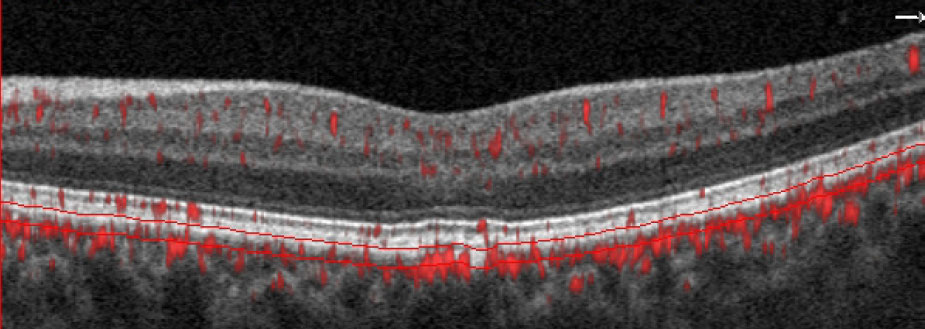 |
| Researchers in this study found that quantitative cutoffs <20.5µm and <10.5µm for Sattler layer-choriocapillaris complex thickness were associated with a moderate and high probability of AMD progression. Photo: Julie Rodman, OD, MSc. Click image to enlarge. |
As part of the ongoing effort to identify reliable biomarkers for the progression of age-related macular degeneration (AMD), researchers of a recent study decided to assess the relationship between disease stage and choroidal overall and sublayer thickness. Specifically, they found that a thinner Sattler layer-choriocapillaris complex may be a telling sign of AMD progression.
The prospective, observational case series observed 262 eyes of 262 patients with varying stages of AMD (12% early, 39% intermediate and 49% late AMD). The following parameters were measured at baseline, at one and two years of follow-up and at a final visit (an average of five years after the baseline visit): AMD stage, choroidal thickness, Sattler layer-choriocapillaris complex thickness and Haller layer thickness.
Each AMD stage group showed a significant decrease in choroidal thickness values throughout follow-up. Sattler layer-choriocapillaris complex thickness reduction showed the strongest association with AMD progression. In addition, the researchers found that for this parameter, “quantitative cutoffs <20.5µm and <10.5µm were associated with a moderate and high probability of AMD progression, respectively, and Sattler layer-choriocapillaris complex thickness quantitative cutoffs <18.5µm and <8.5µm implied a moderate and high probability of macular neovascularization onset, respectively.”
In order for these quantitative cutoffs to be used in clinical practice to determine AMD stage, the researchers suggested larger studies with longer follow-up periods be conducted. One finding validated by the data in this study and others is that progressive choroidal impairment contributes to AMD progression.
“A reduced Sattler layer-choriocapillaris complex thickness is a promising biomarker of disease worsening, and its quantitative evaluation could help to identify patients at higher risk of stage advancement,” the researchers concluded.
Amato A, Arrigo A, Borghesan F, et al. Baseline Sattler layer-choriocapillaris complex thickness cutoffs associated with age-related macular degeneration progression. Retina. May 12, 2022. [Epub ahead of print]. |


